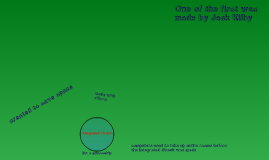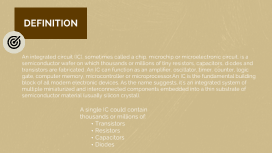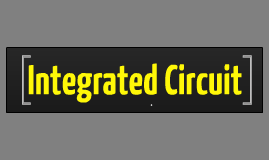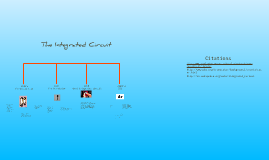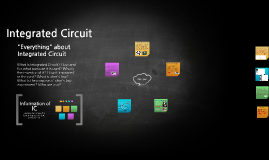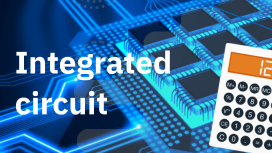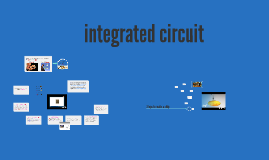Integrated Circuit
Transcript: Question & Hypothesis "What happens to the electric current(A) when the potential(V) gets bigger? "If potential gets bigger, then electric current also gets bigger.' The Materials TI-Nspire, lab cradle, regulated DC power supply, 3 different type resistors, voltage probe and a current sensor. IC The question set before the experiment was "What happens to the electric current when the potential gets bigger?" After the Ohm's Law experiment finished, the graph and data show certain a relationship between the potential and the current. All of the three different graphs draws a rising curve. This means, when the potential increases, the current also increases. The potential and the current are in direct proportional relationship. According to result of the experiment, the hypothesis is proven correct because it states, "if the potential gets bigger, then electric current also gets bigger." *Photolithography: It is process of transferring geometric shapes on a mask to the surface of a silicon wafer. Integrated circuits were invented in 1958 by Jack Kilby, who was an engineer of Texas instruments. He demonstrated successfully the first working integrated circuit device. One and a half years after Kilby demonstrated his IC design, Robert Noyce of Fairchild Semiconductor Limited came up with his own integrated circuit. His model solved many practical problems which Kilby's device had. The earlier developed IC's had only few transistors and resistors on the chip. In the early 1960's SSI(Small Scale Integration) circuits were manufactured. SSI circuits consisted of few tens of components on the chip. Further development in the mid 70's led to LSI(Large Scale Integration), devices which had thousands of transistors per chip. 1KB RAM is an example of a LSI. Then, in early 80's VLSI(Very Large Scale Integration) was introduced. Today we have very complex devices such as ULSI(Ultra Large Scale Integration), SOC(System On Chip), WSI(Waferscale Integration), and 3D-IC(Three dimensional Integrated Circuits). History of Integrated Circuit Before the Ohm's Law experiment... Data & Graph of Ohm's law experiment The IC has two main advantages: cost and performance. Cost is low because the chips, with all their components, are printed as a unit by photolithography rather than being constructed on a transistor one at a time. Performance is high because the IC's components switch quickly and consume little power as a result of the small size and close proximity of the components. After all the materials which are needed for experiment are collected, set up the DC power supply, resistor, voltage probe, current sensor on the table, and connect resistor to regulated DC power supply, voltage probe and current sensor in right order. After that, read the TI-Nspire and check the current and the potential are not in minus. Then, start to increase the potential using DC power supply. Continue increasing for 5 seconds. After, record your data and graph in the TI-Nspire, change the resistor to different one and repeat it again. Information of What is integrated Circuit? How and for what purpose it is used? Who is the inventor of it? How it improved in the past? What is ohm's law? What is the purpose of ohm's law experiment? Who are you? Integrated Circuit Conclusion Thank you! An integrated circuit, IC, is a keystone of modern electronics. It is the heart and brains of most circuits, and set of electronics circuits on one small plate of semiconductor material. It is the ubiquitous little black 'chip' you find on just about every circuit board. It is normally made of silicon. You may cannot see this text. If you see this text, just ignore it. Integrated circuits are used in virtually all electronic equipment today and have revolutionized the world of electronics. Computers, mobile phones, and other digital home appliances are now inextricable parts of the structure of modern societies, made possible by the low cost of integrated circuits. "Everything" about Integrated Circuit "Integrated Circuits." Electrical4u. N.p., n.d. Web. 07 Apr. 2015. <http://electrical4u.com/integrated-circuits-types-of-ic/>. "Integrated Circuits." Sparkfun. N.p., n.d. Web. 07 Apr. 2015. <https://learn.sparkfun.com/tutorials/integrated-circuits>. Keating, Bernie. "Electronics." A Romp Thru Science: Plato and Einstein to Steve Jobs. Bloomington: AuthorHouse, 2012. N. pag. Web. 7 Apr. 2015. Uber, Alessandro. "Integrated Circuit." PhysicalTimingClosure.com. N.p., n.d. Web. 09 Apr. 2015. <http://physicaltimingclosure.com/docs_ic.html>. Procedure of Experiment Works Cited Where are we use ICs? What is an Integrated Circuit? Why are we use ICs?






